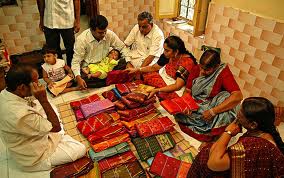Bride Selecting Wedding Saris
History of the Sari
Six yards of exquisite drapery, the Indian sari is feminine garment that is a long strip of unstitched cloth draped in a variety of styles. Its extensively usage is on the Indian subcontinent. An attire worn primarily by Hindu women; once draped about the lower body it gathers in the front in a graceful and decorative effect like the petals of a flower .
The history of the Indian sari is full of tradition, pride, and innovation. It represents the culture of India and symbolizes their way of life. The many ways that it is worn says much of its versatility and durability.
The word ‘sari’ originally from the Prakrit word ‘sattika’ is mentioned in ancient Jain Buddhist scriptures. Its history can be traced back as early as the Indus valley civilization that prospered during the early 1800 BC. Archeological artifacts document to this, in a statue of a priest wearing the drape.
Saris consist of one plain end and one decorative end. The plain end is the one that is wrapped around the body while the decorative end is the one that falls as folds on the front or as a veil (pallu) on the shoulder depending upon the style in which the sari is adorned.
The sari is believed to have originated from the men’s dhoti which is one of the oldest versions of draped garment in India. Originally considered a unisex garment, it was worn by both men and women alike. Ancient saris were of course hand woven, tailored either in silk or in cotton. While the rich could afford the gossamer silk ones but the poor resorted to the cotton ones which in most occasions were very coarsely woven. Since early saris were hand woven they were more expensive and a considerable investment in both money and time. The advent of the British saw the start of the modern era wherein saris were increasingly woven on mechanical looms and made of artificial fibers, such as polyester, nylon, or rayon. This greatly reduced the cost of production which caused the demise of the hand loom industries,
The traditional sari is more than just clothing. There was significant meaning and symbolism attached to the garment in the form of different colors or designs. The various patterns and colors of the sari depicted such information as beliefs, virtues, and the region the person came from.
There were numerous designs and symbols used on the traditional sari. The paisley and fish were used to show fertility. They also represented the abundance of food and children. These patterns were mostly seen in the coastal regions where the people survived on fish.
Designs in the form of an Elephant symbolized water, fertility, wealth and good luck. It also exemplifies the god Ganesh who is the remover of obstacles. The Conch was also a symbol of the gods and represented the bugle used in war.
The use of colors in the sari has also had specific meaning behind them. Red, used in the traditional sense is associated with the warrior and a sign of valor. However, today it is worn by Indian brides and is a favored color by many, because of the sexual and emotional implications attached to it.
White was usually associated with priests because it is believed to be impure to change the sari by use of color or stitching. White is also a symbol of purity and mourning, therefore widows were known to wear the white sari.
The color black was used to show sorrow or bad luck. It was probably for this reason that very few saris were made of black. In contrast, there were many saris made of blue because of the association to the working class. Farmers, weavers and manual laborers were said to have worn blue.
